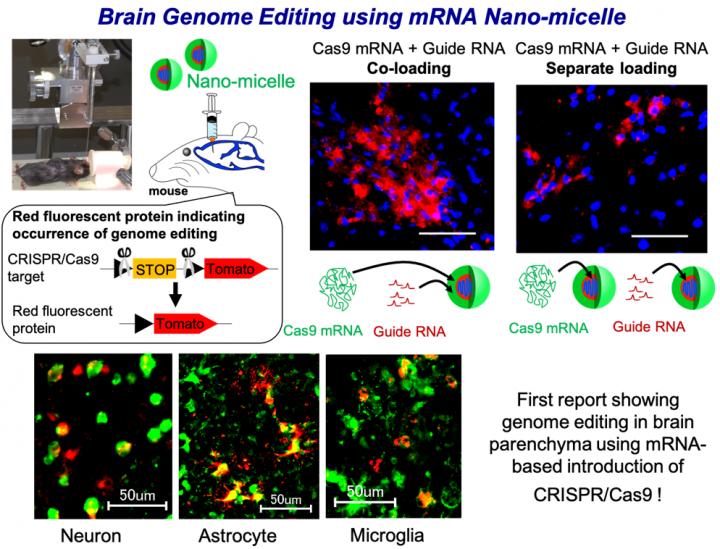
Credit: 2021 Innovation Center of NanoMedicine
March 10, 2021 – Kawasaki, Japan: The research group of Deputy Principal Research Scientist Dr. Satoshi Uchida (Associate Professor, Kyoto Prefectural University of Medicine) at the Innovation Center of NanoMedicine (Director General: Prof. Kazunori Kataoka, Location: Kawasaki-Japan, Abbreviation: iCONM) reported that optimized nano-micelles can induce efficient genome editing in the mouse brain.
The 2020 Chemistry Nobel Prize-winning technology CRISPR/Cas9 holds great promise for treating various diseases such as congenital disorders and viral infections, by correcting the disease-specific genomic sequences. This technology attracted increasing attention in the last decade as it allows easy targeting of genomic sequences with high precision and low level of undesired off-target gene editing. However, safe and efficient delivery of the Cas9 DNA cutting enzyme and guide RNA (gRNA), which is a short piece of RNA that guides Cas9 to its genomic targets, remains an obstacle.
We fabricated nano-micelle for the delivery of Cas9-encoding messenger RNA (mRNA) and gRNA, which condenses these RNAs in the micelle core and forms a protective shell of polyethylene glycol. The efficiency of genome editing was evaluated in transgenic mice which express a red fluorescent protein upon successful genome editing in the mouse brain. Cas9 mRNA (4500 base) and gRNA (100 base) are largely different in size, and when each of them was loaded separately in a nano-micelle, gRNA was rapidly released and degraded. Interestingly, when both Cas9 mRNA and gRNA were loaded in same nano-micelle, the stability of gRNA was increased and this co-loaded nano-micelle allowed more efficient genome editing in various brain cells, such as neurons, astrocytes and microglia (see figure below). To the best of our knowledge, this is the first report validating the utility of RNA-based introduction CRISPR/Cas9 in brain parenchyma. Additionally, the presence of polyethylene glycol on the surface of nano-micelle was found to play a pivotal role in diffusion in the brain tissue after injection, allowing to induce higher genome editing. This nano-micelle represents an efficient and safe tool that could be used for the treatment of genetic brain diseases such as Huntington’s disease, and other neurodegenerative disorders such as Alzheimer’s disease. Saed Abbasi et al published these results in “Journal of Controlled Release” (Impact Factor: 7.727) on March 4th as follows:
“Co-encapsulation of Cas9 mRNA and guide RNA in polyplex micelles enables genome editing in mouse brain”, Saed Abbasi, Satoshi Uchida et al., J. Controlled Release, 332, 260-268 (2021). https:/
###
About Nanomicelle
Polymeric micelles were one of the first polymer self-assemblies reported as a nano-DDS, and are composed of distinct two domains, a drug-loading core and a hydrophilic shell. Amphiphilic block copolymers, containing a hydrophilic block and a hydrophobic block, are firstly revealed to construct those distinct domains in a micelle structure through spontaneous self-assemble as a result of hydrophobic interactions in aqueous.
H. Cabral, K. Miyata, K. Osada, K. Kataoka, “Block copolymer micelles in nanomedicine applications” Chem. Rev. 2018, 118 6844-6892. (DOI: 10.1021/acs.chemrev.8b00199)
Public Interest Incorporated Foundation KAWASAKI INSTITUTE OF INDUSTRIAL PROMOTION
KAWASAKI INSTITUTE OF INDUSTRIAL PROMOTION was established in 1988 funded 100% from Kawasaki City for the purpose of coping with the hollowing out of industry and changes in the demand structure.
In order to realize a higher level of market development, transforming R&D type companies, training technological capabilities to support it, human resources development, understanding market needs, etc., by utilizing the functions of the Kawasaki, KAWASAKI INSTITUTE OF INDUSTRIAL PROMOTION has been contributing to revitalize the local economy by promoting exchanges of local industry information, advancing technology and corporate exchanges with establishment of a R&D institutions, developing creative human resources through workshops and promoting businesses such as expanding sales channels through exhibition business.
http://www.
Innovation Center of NanoMedicine (iCONM)
Innovation Center of NanoMedicine (iCONM) started its operation in April 2015 as a core research center in life science field at King SkyFront on the request of Kawasaki city that KAWASAKI INSTITUTE OF INDUSTRIAL PROMOTION utilized national policies as a business operator and proposer.
It is a unique research center that the world has ever seen which is designed for the purpose of promoting open innovation through industry-academia-government/medical-engineering collaboration, prepared with state-of-the-art facilities and experimental equipment, that enables comprehensive research and development from organic synthesis / microfabrication to preclinical testing.
https:/
Center of Innovation Program (COI)
The COI program is a research and development program under the Ministry of Education, Culture, Sports, Science and Technology and the Japan Science and Technology Agency. The program employs the backcasting approach and set interdisciplinary and collaborative R&D themes that should be challenged at the present from the issues that are underlying in the future society. Eighteen centers have been established nationwide to realize radical innovation through industry-academia collaboration which cannot be accomplished by industry and academia alone.
The Kawasaki center is the only COI center managed by local governments, not universities, and the research projects carried out there are called COINS (Center of Open Innovation Network for Smart Health).
COI: https:/
COINS: https:/
Kyoto Prefectural University of Medicine
In 2022, it will be 150 years since the Kyoto Prefectural University of Medicine, which was first facilitated in Shoren-in Temple and has developed into the present organization, was founded. Fundamental of our university is the education of professionals who have advanced specialized knowledge. With the professional nurses and doctors, our research as a base, we provide world top level of medicine to our region.
https:/
Inquiries
KAWASAKI INSTITUTE OF INDUSTRIAL PROMOTION
Innovation Center of NanoMedicine (iCONM)
COINS Research Promotion Office / Person in charge: Makoto Shimazaki, Mami Satake
Email: [email protected]
Media Contact
Mami Satake
[email protected]
Related Journal Article
http://dx.




